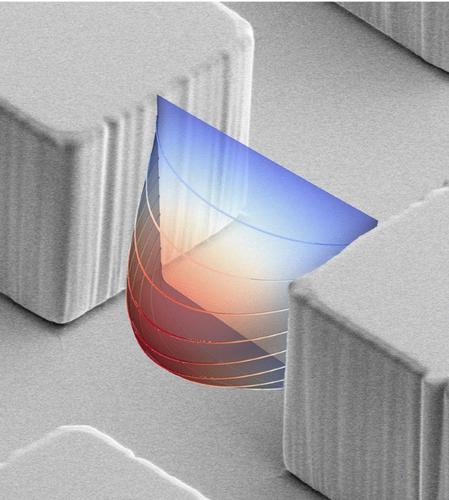当前位置:
X-MOL 学术
›
Transp Porous Media
›
论文详情
Our official English website, www.x-mol.net, welcomes your
feedback! (Note: you will need to create a separate account there.)
The Complexity of Porous Media Flow Characterized in a Microfluidic Model Based on Confocal Laser Scanning Microscopy and Micro-PIV
Transport in Porous Media ( IF 2.7 ) Pub Date : 2020-11-27 , DOI: 10.1007/s11242-020-01515-9 D. A. M. de Winter , K. Weishaupt , S. Scheller , S. Frey , A. Raoof , S. M. Hassanizadeh , R. Helmig
Transport in Porous Media ( IF 2.7 ) Pub Date : 2020-11-27 , DOI: 10.1007/s11242-020-01515-9 D. A. M. de Winter , K. Weishaupt , S. Scheller , S. Frey , A. Raoof , S. M. Hassanizadeh , R. Helmig

|
Abstract In this study, the complexity of a steady-state flow through porous media is revealed using confocal laser scanning microscopy (CLSM). Micro-particle image velocimetry (micro-PIV) is applied to construct movies of colloidal particles. The calculated velocity vector fields from images are further utilized to obtain laminar flow streamlines. Fluid flow through a single straight channel is used to confirm that quantitative CLSM measurements can be conducted. Next, the coupling between the flow in a channel and the movement within an intersecting dead-end region is studied. Quantitative CLSM measurements confirm the numerically determined coupling parameter from earlier work of the authors. The fluid flow complexity is demonstrated using a porous medium consisting of a regular grid of pores in contact with a flowing fluid channel. The porous media structure was further used as the simulation domain for numerical modeling. Both the simulation, based on solving Stokes equations, and the experimental data show presence of non-trivial streamline trajectories across the pore structures. In view of the results, we argue that the hydrodynamic mixing is a combination of non-trivial streamline routing and Brownian motion by pore-scale diffusion. The results provide insight into challenges in upscaling hydrodynamic dispersion from pore scale to representative elementary volume (REV) scale. Furthermore, the successful quantitative validation of CLSM-based data from a microfluidic model fed by an electrical syringe pump provided a valuable benchmark for qualitative validation of computer simulation results. Graphic Abstract
中文翻译:

基于共焦激光扫描显微镜和微 PIV 的微流体模型中表征多孔介质流动的复杂性
摘要 在这项研究中,使用共聚焦激光扫描显微镜 (CLSM) 揭示了通过多孔介质的稳态流动的复杂性。微粒图像测速 (micro-PIV) 用于构建胶体粒子的电影。进一步利用从图像计算出的速度矢量场来获得层流流线。通过单个直通道的流体流动用于确认可以进行定量 CLSM 测量。接下来,研究通道中的流动与相交的死端区域内的运动之间的耦合。定量 CLSM 测量证实了作者早期工作中通过数值确定的耦合参数。使用由与流动流体通道接触的规则孔隙网格组成的多孔介质证明了流体流动的复杂性。多孔介质结构进一步用作数值建模的模拟域。基于求解 Stokes 方程的模拟和实验数据都显示了跨孔隙结构的非平凡流线轨迹的存在。鉴于结果,我们认为流体动力混合是非平凡流线路径和通过孔隙尺度扩散的布朗运动的组合。结果提供了对将流体动力分散从孔隙尺度升级到代表性基本体积 (REV) 尺度的挑战的深入了解。此外,来自电动注射泵的微流体模型的基于 CLSM 的数据的成功定量验证为计算机模拟结果的定性验证提供了有价值的基准。图形摘要 基于求解 Stokes 方程,实验数据显示在整个孔隙结构中存在非平凡的流线轨迹。鉴于结果,我们认为流体动力混合是非平凡流线路径和通过孔隙尺度扩散的布朗运动的组合。结果提供了对将流体动力分散从孔隙尺度升级到代表性基本体积 (REV) 尺度的挑战的深入了解。此外,来自电动注射泵的微流体模型的基于 CLSM 的数据的成功定量验证为计算机模拟结果的定性验证提供了有价值的基准。图形摘要 基于求解 Stokes 方程,实验数据显示在整个孔隙结构中存在非平凡的流线轨迹。鉴于结果,我们认为流体动力混合是非平凡流线路径和通过孔隙尺度扩散的布朗运动的组合。结果提供了对将流体动力分散从孔隙尺度升级到代表性基本体积 (REV) 尺度的挑战的深入了解。此外,来自电动注射泵的微流体模型的基于 CLSM 的数据的成功定量验证为计算机模拟结果的定性验证提供了有价值的基准。图形摘要 我们认为流体动力混合是非平凡流线路径和通过孔隙尺度扩散的布朗运动的组合。结果提供了对将流体动力分散从孔隙尺度升级到代表性基本体积 (REV) 尺度的挑战的深入了解。此外,来自电动注射泵的微流体模型的基于 CLSM 的数据的成功定量验证为计算机模拟结果的定性验证提供了有价值的基准。图形摘要 我们认为流体动力混合是非平凡流线路径和通过孔隙尺度扩散的布朗运动的组合。结果提供了对将流体动力分散从孔隙尺度升级到代表性基本体积 (REV) 尺度的挑战的深入了解。此外,来自电动注射泵的微流体模型的基于 CLSM 的数据的成功定量验证为计算机模拟结果的定性验证提供了有价值的基准。图形摘要 来自由电动注射泵馈送的微流体模型的基于 CLSM 的数据的成功定量验证为计算机模拟结果的定性验证提供了有价值的基准。图形摘要 来自由电动注射泵馈送的微流体模型的基于 CLSM 的数据的成功定量验证为计算机模拟结果的定性验证提供了有价值的基准。图形摘要
更新日期:2020-11-27
中文翻译:

基于共焦激光扫描显微镜和微 PIV 的微流体模型中表征多孔介质流动的复杂性
摘要 在这项研究中,使用共聚焦激光扫描显微镜 (CLSM) 揭示了通过多孔介质的稳态流动的复杂性。微粒图像测速 (micro-PIV) 用于构建胶体粒子的电影。进一步利用从图像计算出的速度矢量场来获得层流流线。通过单个直通道的流体流动用于确认可以进行定量 CLSM 测量。接下来,研究通道中的流动与相交的死端区域内的运动之间的耦合。定量 CLSM 测量证实了作者早期工作中通过数值确定的耦合参数。使用由与流动流体通道接触的规则孔隙网格组成的多孔介质证明了流体流动的复杂性。多孔介质结构进一步用作数值建模的模拟域。基于求解 Stokes 方程的模拟和实验数据都显示了跨孔隙结构的非平凡流线轨迹的存在。鉴于结果,我们认为流体动力混合是非平凡流线路径和通过孔隙尺度扩散的布朗运动的组合。结果提供了对将流体动力分散从孔隙尺度升级到代表性基本体积 (REV) 尺度的挑战的深入了解。此外,来自电动注射泵的微流体模型的基于 CLSM 的数据的成功定量验证为计算机模拟结果的定性验证提供了有价值的基准。图形摘要 基于求解 Stokes 方程,实验数据显示在整个孔隙结构中存在非平凡的流线轨迹。鉴于结果,我们认为流体动力混合是非平凡流线路径和通过孔隙尺度扩散的布朗运动的组合。结果提供了对将流体动力分散从孔隙尺度升级到代表性基本体积 (REV) 尺度的挑战的深入了解。此外,来自电动注射泵的微流体模型的基于 CLSM 的数据的成功定量验证为计算机模拟结果的定性验证提供了有价值的基准。图形摘要 基于求解 Stokes 方程,实验数据显示在整个孔隙结构中存在非平凡的流线轨迹。鉴于结果,我们认为流体动力混合是非平凡流线路径和通过孔隙尺度扩散的布朗运动的组合。结果提供了对将流体动力分散从孔隙尺度升级到代表性基本体积 (REV) 尺度的挑战的深入了解。此外,来自电动注射泵的微流体模型的基于 CLSM 的数据的成功定量验证为计算机模拟结果的定性验证提供了有价值的基准。图形摘要 我们认为流体动力混合是非平凡流线路径和通过孔隙尺度扩散的布朗运动的组合。结果提供了对将流体动力分散从孔隙尺度升级到代表性基本体积 (REV) 尺度的挑战的深入了解。此外,来自电动注射泵的微流体模型的基于 CLSM 的数据的成功定量验证为计算机模拟结果的定性验证提供了有价值的基准。图形摘要 我们认为流体动力混合是非平凡流线路径和通过孔隙尺度扩散的布朗运动的组合。结果提供了对将流体动力分散从孔隙尺度升级到代表性基本体积 (REV) 尺度的挑战的深入了解。此外,来自电动注射泵的微流体模型的基于 CLSM 的数据的成功定量验证为计算机模拟结果的定性验证提供了有价值的基准。图形摘要 来自由电动注射泵馈送的微流体模型的基于 CLSM 的数据的成功定量验证为计算机模拟结果的定性验证提供了有价值的基准。图形摘要 来自由电动注射泵馈送的微流体模型的基于 CLSM 的数据的成功定量验证为计算机模拟结果的定性验证提供了有价值的基准。图形摘要











































 京公网安备 11010802027423号
京公网安备 11010802027423号